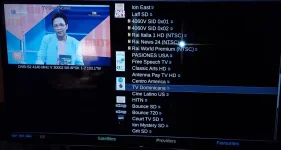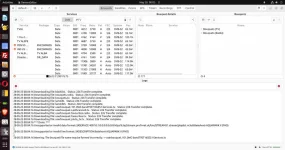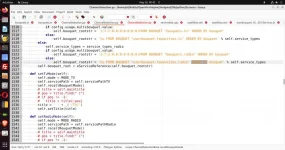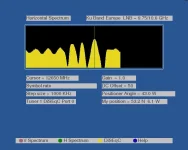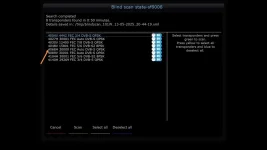Bouquets and lamedb REQUIRE the satellites.xml that they were created with to work properly. A look at the coding will show OE Alliance and OpenPLi use almost identical items when it comes to lamedb and bouquet creation. When you find a bug in one, you usually find the same or similar bug in the other version. Start with post 111 in this thread and you will see indeed bugs or issues that are common in OpenPli are also common in Oe Alliance or OpenVix:
https://forums.openpli.org/topic/102179-testbuild-scarthgap/page-6 . What I am trying to tell you is there is probably nothing wrong with the file structure of TNAP 6. The most likely problem is in what you are trying to put in it. No way to know without seeing seeing the exact files that are trying to be installed.
Yeah. You're probably right. Just don't remember the scenaio occurring before and didn't intend on anyone going off the chain over it. Like pasting in the nims section into settings. Works with other images and apparently not this one. A lesson learned. And perhaps not entirely correct but a satellites.xml is carried along in the lamedb file. No biggie. I remembered some time ago that channels did not stay in the channel editor order. And mistakenly stated there was something buried in the menus to select it.
TNAP 6 begins the integration of AI technology into the image. Some features are built strictly using AI with one example being the wheel loader for Edision driver selection. AI has also assisted in scan edits and other areas of the TNAP 6 image. Provisions are being made to close TNAP and make it strictly a private type image as the bullshit from the fta community is very discouraging at times. People complain about the TNAP image, this forum, and other things that they do not support or have anything to do with. But after close to 25 years on the satellite internet forums, it is understood that people will be people. But at some points, it is nice to hear crickets instead of the noise of city life, hence Closing TNAP may be a great idea.
AI. Crap! I hate my yahoo and other search engines forcing AI search at the top of the listing and down my gullet. BS? How much is really bs and how much is...."Legit"? Personally I've suggested trying tnap to others in other sites. Close it? Meaning like the Airspy SDR# software that used to accept many different software designed radios using EXTIO drivers. Then suddenly shutting their use down like a bull's ass at fly time? And then threatening a crafty guy with a cease and desist when he modded a USRP driver that restored the ability. With the very next version of software released almost the same day that killed it? There are tons of plugins for SDR# written by volunteer coders. But Arispy pushes the use of crappy RTL dongles and garbage. To 'close', or whatever you're getting at would be a very shitty thing to do. Ok, I swore.
Other AI enhancements or starts in TANP 6 include pidscan using TSDuck. While adding a spectrum analyzer seems like a grand idea, in reality it is not going to do a whole lot due to the limits of what is available in receiver resources. A proper pidscan though can show things at times that are normally not seen.
There is a thing called a manifest or in lieu of a manifest
opkg list-installed The manifest will show Samba is already installed in TNAP, so why do we need a menu for something that is already installed??? A careful look at the manifest will also show other things installed by default into the image. The idea behind TNAP is to keep it simple and neat. If something is needed, then add it. There is no reason to have hundreds of plugins in the plugins download when only a few of them even remotely apply to North America. Some Plugins in TNAP exist for Europe because some users there assist in the TNAP design.
Suppose. Not griping one bit. From looking at all of the crap in the plugins menu. For a satellite receiver. Not a media streamer with the option to use a real keyboard and a real mouse. We be kinda' complimicating things for a seemingly simple and neat, training wheels into the fta satellite world....world. If true were true. The user level options in settings would be just like that. Psst...you typo'd....tanp-pon. lol! kidding. It's all good. A beginner using terminal to check a what? Manifest? The flurry of beginner questions. What's a manifest? Maybe a person wants or doesn't want samba, dlna, telnet. I dunno. As long as the damned box don't start muttering ah'll be bock. AI? Seriously?
Ocgaton SF8008...again...
The Octagon SF8008 was released around 2017 if memory serves. It was released with a SiLabs demod referred to as the tuner in receiver menus. Octagon released another SF8008 Supreme in 2023, 2024 year range that had Internal SSD capability and Avalink Demod, which is called tuner in the receiver's menus. This updated receiver also has improved wifi. And Now Octagon releases again the same Si2166D Demod that it originally had in 2017, calling it something "New". This is the exact same receiver from 2017 except for the internal SSD and wifi. All three of these receivers run the exact same image. The coders for Octagon simply stuck the Avalink driver in with the SI2166D driver to make a "One Size Fits All" image.
Rick Caylor was mentioned. Rick Caylor sells stuff. He does not support the stuff he sells and is most likely ignorant about the 3 models of SF8008. Sell it and make a buck. That is the deal, along with squashing any conversation about similar receivers when possible. And automatically delete conversations about cheap receivers. The FTA community in North America is blessed to have a person like Rick, but he is in it for the money and not as a hobby.
Hey man. I'm usually neutral towards a lot of things although I believe valid questions and topics are started and discussed. With a good outcome. Usually. The SF8008. Good points. Although the question remains. Old parts in a newish box and ring around the rosie with different versions of it. The latest being an attempt to validate low symbol rate claims. Right? But software? Drivers? Stagnant or in development or stagnant developments being renewed due to new interests in enhancing what was left out. Simmer down now.
I take it you're bellering it is what it is and it ain't a gonna' get no better. Right?
Before you make harsh decisions. Isn't it any businesses intention to make money? Not that every vendor does 4 years of formal education before starting one.
A recent post over there. Hooked a guy up with a free new actuator. Exhaustively gave telephone support to an owner of an apparently defective 922 receiver. And then others jumped in to hook him up with a diseqc dish mover. What frikkin' demons!! Surely ye jest! Y'all got some sort of a feud going on?
Improvements to the TNAP download site are being made. See:
https://tnapimages.com/
Making improvements to tnapimages.com and other things in life have taken away from improving TNAP 6. But it is all a matter of time, Good Lord willing... OSMio4k, 4kplus, and OSmini4K all use the same driver.
For God sakes man. Don't (shudder) Apple, John Deere, One Wheel your image. Hell dude. It took awhile but you even got me to start using it a bit more. Just a little. But if you scream at little Billy about learning to tie his shoes. He ain't NEVER gonna' learn how to tie 'em.

